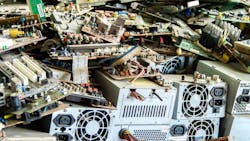Making Electronic Products More Recyclable (.PDF Download)
The European Union (EU) led the way to enforcing collection and recyclability goals back in 2003 with its WEEE Directive (Waste Electrical and Electronic Equipment). Shortly thereafter, the EU’s Eco-Design Directive of 2008 published guidelines for product designs that consider the entire product lifecycle. These measures were further solidified with the 2018 amendment to the EU Waste Framework Directive (WFD), which began to strongly promote the development of a Circular Economy.
Some of the key goals of the Circular Economy include reducing the hazardous substances that may end up as waste by supporting the substitution of substances of concern, and to make information on product content available to waste treatment operators and recyclers.
